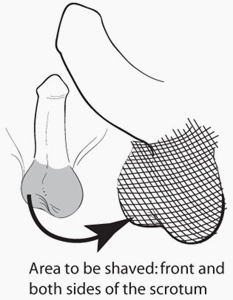A vasectomy is a minor surgical procedure performed for permanent contraception (birth-control). The vas deferens on each side of the scrotum (the "sac") is divided and blocked. The vas is a long tube that runs from each testicle to the urethra (urinary passage). It conducts sperm at the time of ejaculation. When the vas is divided and blocked, the ejaculation fluid (semen) is free of sperm and the egg produced by the woman cannot be fertilized to start a pregnancy.

This procedure should be considered a permanent form of birth control. Although the vas can often be reconnected, achieving a pregnancy may be more difficult due to a number of factors affecting the quality of the sperm and the tubes' ability to heal.
The procedure can be performed in a physician’s office or at your local hospital. On the day of a vasectomy, before the procedure, one may need to shave the hair from the front part of the scrotum, if advised to do so by the physician.

On the day of the vasectomy, the patient is taken to a treatment room and asked to lie down on an examination table. The scrotal skin will be cleaned with an antiseptic solution, after which the patient is covered with a sterile sheet to minimize the risk of infection.
Vasectomies usually are performed with local anaesthesia. The skin and vas are “frozen” with an anaesthetic solution injected through a fine needle. This blocks the sensation of pain, although one may still notice some pressure and pulling.
A small opening is made in the scrotal skin over the vas. Each vas is then divided, and blocked off with clips or sutures. Any bleeding which might occur is controlled. A dissolving stitch may be used to close the skin opening. The procedure is completed usually in 10 to 20 minutes. A small dressing may be applied, which you can remove the next day.

After the procedure One should plan to restrict activities for the first two or three days after a vasectomy. Avoid strenuous physical activity, heavy lifting, or exercise for about one week. Any strain may cause bleeding or swelling of the scrotum. A mild painkiller can be used as required when the local anaesthetic has worn off.
Sexual activity and exercise may be resumed when comfortable, usually within one week. After a vasectomy, one will remain fertile for several weeks due to sperm remaining in the tubes and glands. Another form of birth control should be used until ejaculation clears out these remaining sperm and laboratory examination of a semen sample shows that no sperm are present in the ejaculated fluid.
Most men have no problem after a vasectomy except for some mild discomfort that may last for a few days. There is, however, a small risk of infection requiring treatment with antibiotics. It is more common to have some scrotal swelling and bruising, which should be treated with an ice pack. The ice pack should be wrapped in a thin towel so that the ice does not directly contact the skin. Pain medications should be used as directed by your physician. Acetaminophen (i.e. TylenolTM) or ibuprofen (i.e. AdvilTM)may help with any discomfort. Some men have scrotal pain that persists for a few weeks or months. Over time, this usually resolves completely without specific treatment. Normally, a small lump will develop in each vas at the site of division.
Very rarely over time, the cut ends of the vas may heal back together allowing sperm to re-enter the semen and fertility to return resulting in pregnancy.
A vasectomy should not affect sexual function nor will there be any change in the semen.
There is no reason to believe that having a vasectomy can cause other health problems.